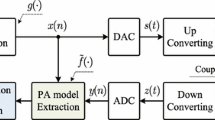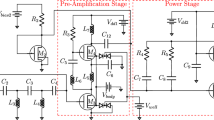Abstract
In reconfigurable power amplifiers (PAs), the efficiency can be improved by dynamically switching the discrete gain mode according to the input envelope amplitude. Nevertheless, discontinuities that occur between gain mode changes critically compromise the linearization capability of traditional digital baseband predistorters (DPDs) based on continuous polynomials with memory. To circumvent such drawback, this work introduces a model based on polynomials bounded at both sides and able to take into account commutation delays. Besides, two novel approaches are presented to the model order reduction without basis change. The effectiveness of the proposed approaches to linearize a 130 nm CMOS class AB PA commutating in real time among three gain modes is certified based on Cadence Virtuoso and Matlab simulations. The proposed memory polynomial-based model was able to accurately model both direct and inverse transfer characteristics of a three gain mode PA, showing normalized mean square error results of about − 41 dB. Besides, a 25.5 dB reduction in adjacent channel power ratio is provided by the inclusion of a 10 parameters DPD that adopts the proposed approaches, in comparison with unlinearized PA of same output mean power.


















Similar content being viewed by others
References
A. Abdelhafiz, A. Kwan, O. Hammi, F.M. Ghannouchi, Digital predistortion of LTE-A power amplifiers using compressed-sampling-based unstructured pruning of Volterra series. IEEE Trans. Microw. Theory Tech. (2014). https://doi.org/10.1109/TMTT.2014.2360845
K.H. An, D.H. Lee, O. Lee, H. Kim, J. Han, J. Kim, C. Lee, H. Kim, J. Laskar, A 2.4 GHz fully integrated linear CMOS power amplifier with discrete power control. IEEE Microw. Wirel. Compon. Lett. (2009). https://doi.org/10.1109/LMWC.2009.2022141
A.R. Belabad, S.A. Motamedi, S. Sharifian, A novel generalized parallel two-box structure for behavior modeling and digital predistortion of RF power amplifiers at LTE applications. Circuits Syst. Signal Process. (2017). https://doi.org/10.1007/s00034-017-0700-9
N. Bhushan, J. Li, D. Malladi, R. Gilmore, D. Brenner, A. Damnjanovic, R.T. Sukhavasi, C. Patel, S. Geirhofer, Network densification: the dominant theme for wireless evolution into 5G. IEEE Commun. Mag. (2014). https://doi.org/10.1109/MCOM.2014.6736747
E.J. Bonfim, E.G. de Lima, A modified two dimensional Volterra-based series for the low-pass equivalent behavioral modeling of RF power amplifiers. Progress Electromagn. Res. M (2016). https://doi.org/10.2528/PIERM15122806
S. Chen, C.F.N. Cowan, P.M. Grant, Orthogonal least squares learning algorithm for radial basis function networks. IEEE Trans. Neural Netw. (1991). https://doi.org/10.1109/72.80341
S. Chen, X. Hong, C.J. Harris, Fully complex-valued radial basis function networks for orthogonal least squares regression, in 2008 IEEE International Joint Conference on Neural Networks (IEEE World Congress on Computational Intelligence) (2008). https://doi.org/10.1109/IJCNN.2008.4633759
S. Cripps, RF Power Amplifiers for Wireless Communications, 2nd edn. (Artech House, Norwood, MA, 2006)
C. Eun, E.J. Powers, A new volterra predistorter based on the indirect learning architecture. IEEE Trans. Signal Process. (1997). https://doi.org/10.1109/78.552219
P.L. Gilabert, G. Montoro, D. López, N. Bartzoudis, E. Bertran, M. Payaró, A. Hourtane, Order reduction of wideband digital predistorters using principal component analysis, in 2013 IEEE MTT-S International Microwave Symposium Digest (MTT) (2013). https://doi.org/10.1109/MWSYM.2013.6697687
R. Giofré, L. Piazzon, P. Colantonio, F. Giannini, A Doherty architecture with high feasibility and defined bandwidth behavior. IEEE Trans. Microw. Theory Tech. (2013). https://doi.org/10.1109/TMTT.2013.2274432
M.R. Hasin, J. Kitchen, A compact watt-level GaN-on-Si class AB power amplifier for handset applications, in 2017 Texas Symposium on Wireless and Microwave Circuits and Systems (WMCS) (2017). https://doi.org/10.1109/WMCaS.2017.8070682
D. Kang, B. Park, D. Kim, J. Kim, Y. Cho, B. Kim, Envelope-tracking CMOS power amplifier module for LTE applications. IEEE Trans. Microw. Theory Techn. (2013). https://doi.org/10.1109/TMTT.2013.2280186
P.B. Kenington, High Linearity RF Amplifier Design (Artech House, Norwood, MA, 2000)
J. Kim, K. Konstantinou, Digital predistortion of wideband signals based on power amplifier model with memory. Electron. Lett. (2001). https://doi.org/10.1049/el:20010940
B.M. Lee, R.J.P. de Figueiredo, Adaptive predistorters for linearization of high-power amplifiers in OFDM wireless communications. Circuits Syst. Signal Process. (2006). https://doi.org/10.1007/s00034-004-0901-x
E.G. Lima, T.R. Cunha, J.C. Pedro, A physically meaningful neural network behavioral model for wireless transmitters exhibiting PM-AM/PM-PM distortions. IEEE Trans. Microw. Theory Techn. (2011). https://doi.org/10.1109/TMTT.2011.2171709
W.A. Malik, A.F.A. Sheta, I. Elshafiey, A broadband high efficiency class AB GaN HEMT balanced power amplifier, in 2017 8th International Conference on Information Technology (ICIT) (2017). https://doi.org/10.1109/ICITECH.2017.8079979
V. Mathews, G. Sicuranza, Polynomial Signal Processing (Wiley, New York, 2000)
J.C. Mayeda, D.Y.C., Lie, J. Lopez, A highly efficient and linear 15 GHz GaN power amplifier design for 5G communications, in 2017 Texas Symposium on Wireless and Microwave Circuits and Systems (WMCS) (2017). https://doi.org/10.1109/WMCaS.2017.8070699
R. Meshkin, A. Saberkari, M. Niaboli-Guilani, A novel 2.4 GHz CMOS class-E power amplifier with efficient power control for wireless communications, in 17th IEEE Int. Conf. Electron. Circuits Syst (2010). https://doi.org/10.1109/ICECS.2010.5724583
L.A.A. Montes, K. Raja, F.U.H.G. Wong, M. Je, An efficient power control scheme for a 2.4 GHz class-E PA in 0.13-\(\mu \)m CMOS, in IEEE Ninth International Conference on Intelligent Sensors, Sensor Networks and Information Processing Singapore (2014). https://doi.org/10.1109/ISSNIP.2014.6827687
D.R. Morgan, Z. Ma, J. Kim, M.G. Zierdt, J. Pastalan, A generalized memory polynomial model for digital predistortion of RF power amplifiers. IEEE Trans. Signal Process. (2006). https://doi.org/10.1109/TSP.2006.879264
M.S. Muha, C.J. Clark, A.A. Moulthrop, C.P. Silva, Validation of power amplifier nonlinear block models, in 1999 IEEE MTT-S International Microwave Symposium Digest (Cat. No.99CH36282) (1999). https://doi.org/10.1109/MWSYM.1999.779870
W. Pan, Y. Liu, S. Shao, Y. Tang, A method to reduce sampling rate of the ADC in feedback channel for wideband digital predistortion. Circuits Syst. Signal Process. (2014). https://doi.org/10.1007/s00034-014-9751-3
J.C. Pedro, S.A. Maas, A comparative overview of microwave and wireless power-amplifier behavioral modeling approaches. IEEE Trans. Microw. Theory Techn. (2005). https://doi.org/10.1109/TMTT.2005.845723
F.H. Raab, P. Asbeck, S. Cripps, P.B. Kenington, Z.B. Popovic, N. Pothecary, J.F. Sevic, N.O. Sokal, Power amplifiers and transmitters for RF and microwave. IEEE Trans. Microw. Theory Techn. (2002). https://doi.org/10.1109/22.989965
D. Raychaudhuri, N.B. Mandayam, Frontiers of wireless and mobile communications. Proc. IEEE (2012). https://doi.org/10.1109/JPROC.2011.2182095
H.D. Rodrigues, T.C. Pimenta, R.A.A. de Souza, L.L. Mendes, Orthogonal scalar feedback digital pre-distortion linearization. IEEE Trans. Broadcast. (2017). https://doi.org/10.1109/TBC.2017.2755261
E.L. Santos, B. Leite, A. Mariano, Multimode 2.4 GHz CMOS power amplifier with gain control for efficiency enhancement at power backoff, in 2015 IEEE 6th Latin American Symposium on Circuits Systems (LASCAS) (2015). https://doi.org/10.1109/LASCAS.2015.7250427
E.L. Santos, M.A. Rios, L. Schuartz, B. Leite, L. Lolis, E.G. Lima, A.A. Mariano, A fully integrated CMOS power amplifier with discrete gain control for efficiency enhancement. Microelectron. J. (2017). https://doi.org/10.1016/j.mejo.2017.09.009
F. Santos, A. Mariano, B. Leite, 2.4 GHz CMOS digitally programmable power amplifier for power back-off operation, in 2016 IEEE 7th Latin American Symposium on Circuits Systems (LASCAS) (2016). https://doi.org/10.1109/LASCAS.2016.7451034
M. Schetzen, Nonlinear system modeling based on the Wiener theory. Proc. IEEE (1981). https://doi.org/10.1109/PROC.1981.12201
A.S. Tehrani, H. Cao, S. Afsardoost, T. Eriksson, M. Isaksson, C. Fager, A comparative analysis of the complexity/accuracy tradeoff in power amplifier behavioral models. IEEE Trans. Microw. Theory Techn. (2010). https://doi.org/10.1109/TMTT.2010.2047920
A. Tufféry, N. Deltimple, E. Kerhervé, V. Knopik, P. Cathelin, CMOS fully integrated reconfigurable power amplifier with efficiency enhancement for LTE applications. Electron. Lett. (2015). https://doi.org/10.1049/el.2014.3525
P. Varahram, J. Dooley, K. Finnerty, R. Farrell, A digital pre-distortion based on nonlinear autoregressive with exogenous inputs. IEEE Microw. Wirel. Compon. Lett. (2016). https://doi.org/10.1109/LMWC.2016.2549178
J. Wood, Digital pre-distortion of RF power amplifiers: progress to date and future challenges, in 2015 IEEE MTT-S International Microwave Symposium (2015). https://doi.org/10.1109/MWSYM.2015.7166711
X. Yu, H. Jiang, Digital predistortion using adaptive basis functions. IEEE Trans. Circuits Syst. I Regul. Pap. (2013). https://doi.org/10.1109/TCSI.2013.2265958
R. Zhang, M. Acar, M.P. van der Heijden, M. Apostolidou, D.M.W. Leenaerts, Generalized semi-analytical design methodology of class-E outphasing power amplifier. IEEE Trans. Circuits Syst. I Regul. Pap. (2014). https://doi.org/10.1109/TCSI.2014.2327278
A. Zhu, P.J. Draxler, C. Hsia, T.J. Brazil, D.F. Kimball, P.M. Asbeck, Digital predistortion for envelope-tracking power amplifiers using decomposed piecewise Volterra series. IEEE Trans. Microw. Theory. Techn. (2008). https://doi.org/10.1109/TMTT.2008.2003529
Acknowledgements
This study was financed in part by the Coordenação de Aperfeiçoamento de Pessoal de Nível Superior - Brasil (CAPES) - Finance Code 001 and by National Council for Scientific and Technological Development (CNPq).
Author information
Authors and Affiliations
Corresponding author
Additional information
Publisher's Note
Springer Nature remains neutral with regard to jurisdictional claims in published maps and institutional affiliations.
Rights and permissions
About this article
Cite this article
Schuartz, L., Santos, E.L., Leite, B. et al. Reduced-Complexity Polynomials with Memory Applied to the Linearization of Power Amplifiers with Real-Time Discrete Gain Control. Circuits Syst Signal Process 38, 3901–3930 (2019). https://doi.org/10.1007/s00034-019-01049-6
Received:
Revised:
Accepted:
Published:
Issue Date:
DOI: https://doi.org/10.1007/s00034-019-01049-6




